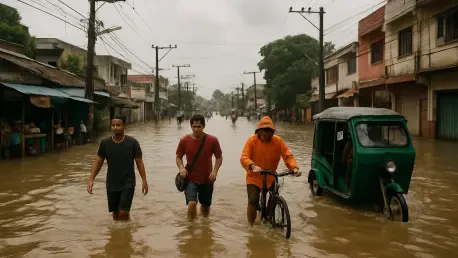In the heart of Iloilo City, Philippines, relentless flooding continues to disrupt lives and livelihoods, even as billions of pesos have been poured into ambitious flood control initiatives over recent years. Despite nearly P1.75 billion allocated for mitigation efforts since records began tracking such extensive funding, residents still wade through inundated streets during heavy rains, and downstream communities bear the brunt of worsened conditions. This staggering investment, including a significant P1 billion this year alone, raises pressing questions about why tangible results remain elusive. The frustration among locals is palpable, as many feel left in the dark about the progress and impact of these projects, while skepticism grows over whether the funds are being utilized effectively to safeguard vulnerable areas.
Unpacking the Financial Scale and Contractor Dominance
A closer look at the financial landscape reveals a striking concentration of resources directed toward flood mitigation in Iloilo City, with a substantial portion of contracts awarded to a select group of firms. Over the past few years, companies linked to the Discaya family have secured contracts worth hundreds of millions, including P526.8 million this year and P374.6 million in the prior year. These firms, bearing names like St. Timothy Construction Corporation and Alpha & Omega General Contractor, dominate the local infrastructure scene. Yet, despite this influx of funding, barangays across the city remain submerged during downpours, and nearby areas like Oton have faced prolonged flooding, with several villages underwater for days due to river embankments. Public discontent simmers as transparency around project execution appears lacking, with some initiatives conspicuously absent from national tracking systems, further fueling doubts about accountability in how these vast sums are managed.
Probing Accountability and Systemic Challenges
Delving into the broader systemic issues, the persistent flooding in Iloilo City reflects deeper challenges in infrastructure governance that extend beyond mere funding. Investigations at both Senate and House levels have spotlighted potential irregularities in contract allocations, with key figures from the Discaya family under intense scrutiny for their business practices. Congressional leaders have distanced themselves from responsibility over contractor selection, pointing to regional engineering offices and the Department of Public Works and Highways as the decision-makers in the bidding process. Meanwhile, national probes have escalated, with contempt charges and show-cause orders issued to implicated individuals. For residents, the lack of improvement despite massive investments is looked back on with disappointment, as past efforts failed to deliver promised relief. Moving forward, stricter oversight, enhanced transparency in project tracking, and a reevaluation of contractor selection processes stand as critical steps to ensure future funds translate into real protection against the relentless floods.









